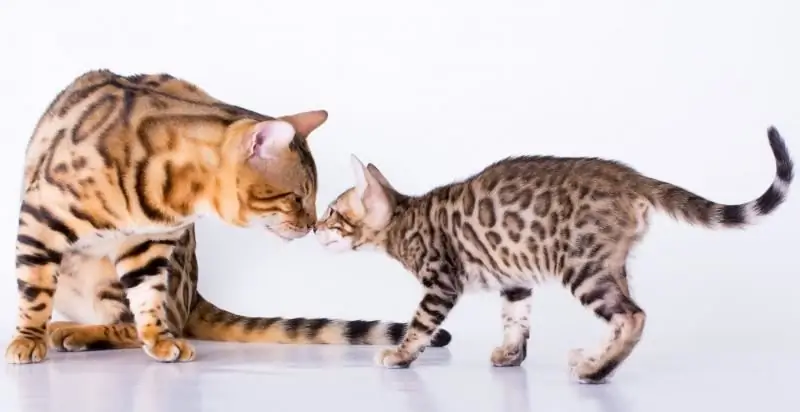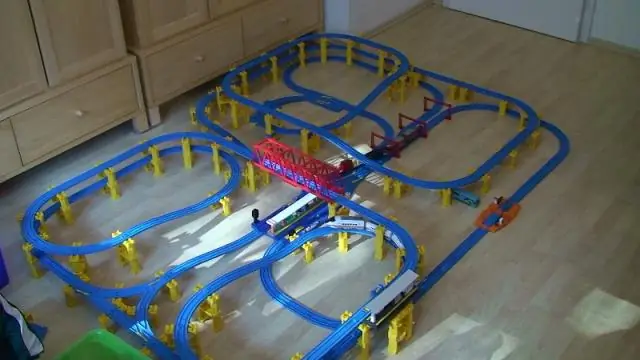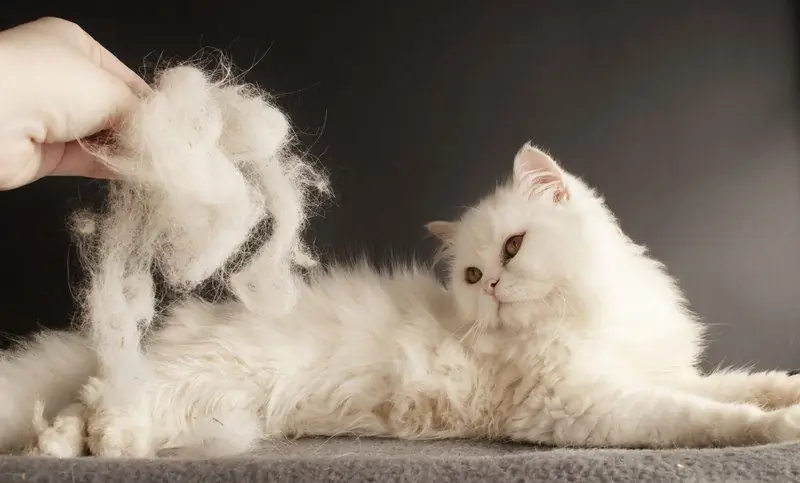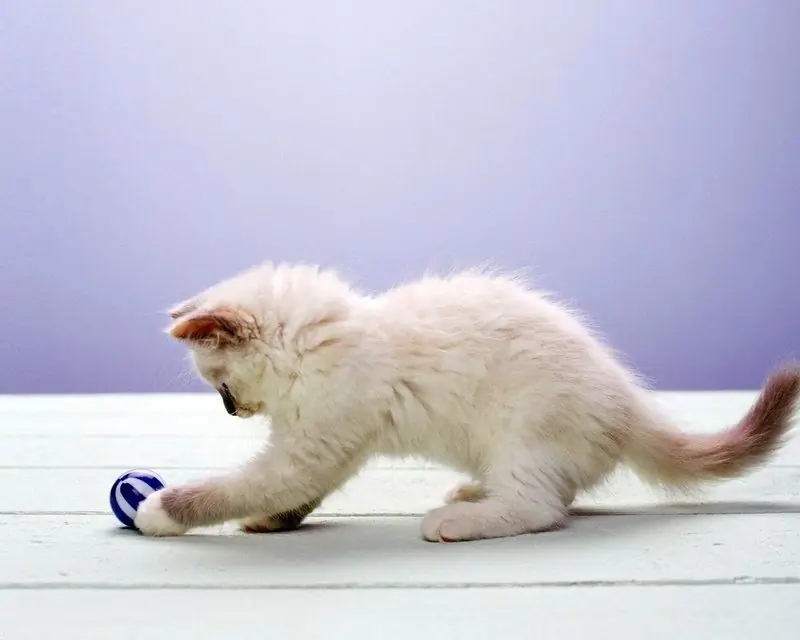
Table of contents:
- Author Bailey Albertson [email protected].
- Public 2023-12-17 12:53.
- Last modified 2025-06-01 07:32.
Domestic cats - anatomy of grace

Cats are one of the most popular pets, which only dogs can compete with in terms of the strength of people's love. It is always a pleasure to spend time with a cat - the animal will keep company, substitute its fluffy back under the arm, curl up in a ball on its feet and purr soothingly. The organism of these small and cute predators is very interesting, and some features even gave rise to a lot of myths and rumors about cats.
Content
-
1 Species
1.1 Video: how domestic cats appeared
-
2 Feline anatomy
-
2.1 Dimensions and weight
2.1.1 Table: average sizes of cats of some breeds
-
2.2 Skeleton
- 2.2.1 Features of the structure of the skull and dental formula
- 2.2.2 Caudal spine
- 2.2.3 Muscular system and joints
- 2.3 Leather and wool
-
2.4 Sense organs
- 2.4.1 Vision
- 2.4.2 Smell
- 2.4.3 Hearing
- 2.4.4 Touch
- 2.4.5 Gustatory perception
- 2.4.6 Vestibular apparatus
- 2.5 Digestive and excretory systems
- 2.6 Endocrine system and nervous regulation
- 2.7 Breeding system
-
- 3 A bit of psychology: the system of signs and self-expression in behavior
Species affiliation
The term "companion animal" exists to refer to those pets that a person keeps at home solely for receiving pleasant emotions and communication. Cats definitely belong to this category, because they are tolerant of people, get along well with them, have a playful character and attractive appearance.
The domestic cat, or Felis catus, belongs to the class of mammals and the feline family. This is the smallest representative of the predatory order of this family, which includes both purebred and outbred animals. It is impossible to establish the number of cats on Earth, since there are no clear statistics and unified criteria on this issue that would allow the representatives to be classified as domestic.

Domestic cats are the smallest representatives of the feline family
Video: how domestic cats appeared
Cat anatomy
Representatives of felines have many features that are hidden not only in the structure of organs and systems, but also in their functions.
Dimensions and weight
The average weight of a domestic cat is 2.5-4 kg for females and 4-6 kg for males (they are larger in all breeds), the body length is 50-60 cm, and the tail is 20-35 cm. These are the average data that can vary greatly from breed to breed.
Table: average sizes of cats of some breeds
| Breed | Females weight, kg | Male weight, kg | Body length, cm | Tail length, cm |
| Abyssinian cat | 2.5-5.5 | 3.5-7 | 45-50 | 30-35 |
| British Shorthair | 3-5 | 5-7 | 50-60 | 30-35 |
| Canadian sphinx | 3-4 | 3.5-5 | 45-50 | 30-35 |
| Kurilian Bobtail | 2.5-4 | 5-8 | 45-50 | 3-8 |
| Munchkin | 2-3.5 | 3-4 | 40-45 | 25-30 |
| Maine Coon | 4.5-7.5 | 9-15 | 70-85 | 45-60 |
| Persian cat | 3.5-5 | 4.5-7 | 50-60 | 30-35 |
| Siamese cat | 3-4 | 4-5 | 55-65 | 35-40 |
| Savannah | 7-11 | 9-15 | 80-100 | 60-70 |
| Singapore cat | 1.5-2 | 2-3 | 30-40 | 20-25 |
Skeleton
The smallest feline has more bones in its body than humans - 240-250 elements (humans have 205-207). The skeleton is divided into two sections:
- axial - the bones of the skull, the spine itself and the chest;
- peripheral - 2 limbs, front and back.

The skeleton of a cat consists of approximately 250 bones.
In total, there are 30 main vertebrae in the feline spine and from 20 to 26 (depending on breed and genetic characteristics) caudal vertebrae. Of the main, 7 refers to the cervical region, the thoracic region has 13 vertebrae, the lumbar region - 7, and then there are 3 fused sacrum elements (they are rigidly connected together due to the need to attach the hind legs, which have a huge load during movement) …
An important feature of the cat's skeleton is the absence of clavicular bones. This gives the animal special flexibility - if desired, it can crawl through absolutely any gap where the head will pass. Cats differ in the structure of their claws - domestic representatives of cats, due to the special structure of their fingers, can draw their weapons into leather cases at the ends of the last phalanges.

The cat has the ability to retract claws into special skin sacs
Features of the structure of the skull and dental formula
The cat's skull can be distinguished by its well-developed jaws and large eye sockets. An important feature is the approximately the same development of the brain and facial parts. There are 24 bones in the animal's skull, 13 of which are on a part of the face. Such a powerful front part is due to the predatory nature - strong jaws are simply necessary for hunting, they help to grab, hold, grind food, and, if necessary, also defend.

A feature of the cat's skull is the same size of the brain and facial parts, which is due to the predatory nature of the animal
The first milk teeth appear in kittens at 4-5 weeks, and all erupt completely by two months. In the period up to six months, a gradual change in the dentition begins, and by 9 months a permanent bite is normally formed. An adult has 3 dozen teeth, while their location in the oral cavity is uneven - there are 16 dental elements on the upper jaw (6 incisors, 2 canines, 4 molars on each side, the dental formula is 3 incisors, 1 canine, 3 premolars, 1 molar), and on the bottom - only 14 (6 incisors, 2 canines and 3 molars on the left and on the right, the dental formula - 3 incisors, 1 canine, 2 premolars, 1 molar).

An adult cat has 16 teeth on the upper jaw, and 14 on the lower
Caudal spine
The tail section is on average 10% of the entire skeleton in terms of the number of bone elements. The tail starts from the sacrum, its stem consists of 10-15 elongated cylindrical vertebrae. Towards the end, the elements become shorter and smaller, the last terminal process is usually underdeveloped and sharp. The tail is very mobile due to the structure of the intervertebral cartilage.
This part of the spine plays an important role in the coordination of the cat's movements - it is a kind of steering wheel that allows you to align the trajectory while moving. When falling from a height, tail balancing helps to roll over into a safe position with the legs down. It is also needed for other purposes:
- expression of mood: when the animal is comfortable, its tail is at rest or the very tip sways slightly, and when irritated, it twitches nervously from side to side;
-
touch: this part of the body is somewhat similar to a mustache - thanks to it, the cat feels the surrounding space better, can better navigate in the absence of light, as if "probing" the place;

Cat tail The tail helps the cat to maintain balance, express mood, navigate in space and produce thermoregulation
- thermoregulation: during the heat, the cat can fan itself with its tail, and in cold weather it can curl up into a ball, covering its muzzle with its tail.
However, some breeds do not have a tail at all (Manx, Cimrick, Rampy), some animals lose it due to injuries, and this suggests that a cat can do without it successfully, without limiting itself either in jumping or in balancing. edge. All functions of the caudal region can be compensated for by other parts of the body and sense organs, so its absence is not critical.
Muscular system and joints
In addition to bones, the skeleton includes joints, tendons, and muscles. A newborn kitten has a complete set of all elements of the skeleton, and its increase in size with age is due solely to their proportional growth, and not to an increase in quantity. The main function of the animal's muscles is to ensure the mobility of the body and the work of organs. There are two groups:
- smooth muscles - they are located in the internal organs, ensuring their work, and are not controlled by the will of the animal, that is, they work reflexively;
- striated muscles - they are for the most part located on the bone skeleton and allow it to move; the cat controls them consciously, realizing both eye movements and running with their help.
There are about five hundred muscles in the musculature of a cat. Each has its own purpose, for example:
- the gluteal muscles straighten the thigh;
- tailors - raise their knees;
- triceps straightens the shoulder, etc.
Tendons are tough tissue that is necessary for the attachment of muscle elements to the bones of the skeleton. The joint, in turn, is located at the junction of two bones - this is cartilage tissue with a lubricating fluid that provides comfortable movement.
Leather and wool
The skin of a cat consists of the epidermis, the skin itself (the dermis, in which the hair follicles, glands, blood vessels and nerve endings are located) and the subcutaneous layer with fatty deposits. The organ covering the entire body protects against external influences, including friction, shock, ultraviolet radiation, and bacterial attack. One of the most important functions is thermoregulation: by narrowing or expanding the vessels in the dermis, the body temperature is corrected - a well-established system allows even very fluffy breeds not to overheat in the heat.

A cat's skin is composed of the epidermis, dermis and subcutaneous layer
Almost the entire body of cats is covered with hair (except for hairless representatives). Exceptions are some small "naked" areas: nose, paw pads, inner surface of the auricles, lips. The coat is represented by two types of hairs: ost (coarse guard hair, which determines the color of the animal) and soft undercoat. Hair is necessary to protect the pet from mechanical damage, it helps to regulate body temperature.

Cat's coat consists of coarse, color-forming hairs and a soft undercoat
Sense organs
Well-developed senses help domestic cats in many ways to be agile and careful - this is one of the advantages of predators.
Vision
One of the features of cats is their vision, it has a lot of interesting properties. First of all, a cat's vision is binocular, that is, an animal can see an object with both eyes equally clearly. The eyes are able to refract the light beam from any source due to a special layer under the retina - the tapetum, so that the pet can see even under very poor lighting conditions.

Cat's eyes are able to reflect light from even the faintest source.
The eyes of all breeds are quite large, and in the inner corner there is a blinking membrane - the third eyelid, which protects the eye from injury, including dust. Due to the location of the eyes, cats have stereoscopic vision - the visible fields are superimposed on each other, and the angle of view of each eye is 205 degrees, giving accurate information about the environment and distance to objects.
Cat eyes have a few more interesting features:
- until recently, it was believed that these pets see the world in black and white, but it turned out that this is not so: they have few color receptors, but they are still able to distinguish primary colors;
- cats do not see closely and motionless objects, so finding a toy that fell silently can be difficult;
- cats see poorly in bright light, since the eye closes as much as possible due to constriction of the pupil;
- the form and activity of using the eyes necessitates constant washing with tears, and in large quantities.
Smell
The cat's nose is very sensitive - the area of the epithelium capable of perceiving odors is twice that of humans, which makes the animal's sense of smell more than 10 times stronger than that of humans. The skin around the nostrils is devoid of hair, and there is a strip in the middle that separates the upper lip. Thanks to its sense of smell, the pet finds food, navigates the territory, distinguishes "messages" left by other animals by means of excrement and marks.

The cat's nose is completely hairless and small in size
Hearing
The organ of hearing - the ear - in a cat is divided into three sections: the outer, middle and inner ear, from the latter, impulses enter the corresponding parts of the brain. This feeling in felines is very well developed, for this there are a number of favorable physiological conditions:
- erect large auricles;
-
significant ear mobility;

Cat ears Ears in cats are large and mobile
- a large number of nerve endings in the organ.
Directional hearing of an animal is not fully understood, according to various studies, the range of sounds perceived by cats is 45-64000 Hz, and can go up to 100 thousand hertz. For comparison - a person is able to pick up sounds with a frequency of only 20 thousand Hz.
Touch
The tactile function in the feline body is performed by tactile hairs located above the upper lip on both sides, above the eyes, under the chin, and sensitive areas of hair on the tail, wrists, in the ears and at their ends, as well as between the toes. The system of tactile points helps the animal to navigate in space, even if other senses are not included in the work. So, a cat in the dark will not bump into a wall - the sensitive antennae on the face will be the first to touch the obstacle and warn the animal.

Tactile hairs on the face and body of the cat allow him to navigate in space even in complete darkness
Taste perception
The cat's tongue is able to recognize salty, sour, bitter and sweet. The organ is covered with taste buds and, from the point of view of the perception of taste, works similarly to a human. However, the structure of the surface of the tongue has its own characteristics - horny hooks directed towards the pharynx, which are perceived to the touch as a strong roughness. These hooks play a large role in chewing food - they help break the pieces into fibers, which makes chewing easier.

The tongue of the cat is covered with numerous hooks that help to tear food and comb hair
The cat's tongue has several purposes:
- comb for wool: when licking, due to the structure of the surface of the tongue, the cat can effectively comb its fur, unravel the stray lump;
- an element of thermoregulation: the tongue is a heat dissipator; in extreme heat, breathing through the mouth helps the animal cool down;
- organ of taste - it is on the tongue that the zones of perception of taste sensations are located.
Vestibular apparatus
In the inner part of the ear there is a special apparatus responsible for the sense of balance - the vestibular one. It allows the animal to:
- move along the edge of fences, roofs;
- walk on thin tree branches and other unstable surfaces;
- take a position with his back up and paws down for landing when falling from a height.
Digestive and excretory systems
The digestive system is made up of a number of elements:
- the oral cavity, where the process of food processing begins;
- pharynx;
- esophagus;
- stomach;
- small and large intestines;
- rectum;
- anus (from which the remnants of the processed masses come out);
- organs of internal secretion (liver, pancreas, gallbladder).
A lot of vital functions are assigned to these organs:
- chopping food, mixing and moving it to create a food coma;
- the allocation of special enzymes for the digestion process;
- absorption of nutrients into the blood and lymph;
- release of waste products into the environment, cleaning the body;
- release of digestive hormones.
The processing of food from the moment the animal has consumed it until the residues are excreted by the body takes on average a day. The pet's body is designed to receive frequent small portions, which should be taken into account when organizing feedings.
Excess fluid is excreted through the urinary system. In domestic predators, it has no features and includes two kidneys, ureters extending from them to the bladder and a canal connecting the storage organ with the external opening for urine output - the urethra. In one day, about 100 ml of liquid waste is produced in the kidneys of an average-sized cat, which go out through the opening in the vagina in females and the opening at the end of the penis in males.
Endocrine system and nervous regulation
The endocrine system is built from a set of elements - organs and glands - responsible for the production of hormones. Both they and the senses transmit information to the brain, where the processed signal serves as an impetus for the transmission of commands throughout the body. In its structure, the cat's brain does not differ from the brain of other mammals, its weight is on average 0.9% of body weight (about 30 g), and the spinal cord serves as the main highway for the delivery of nerve signals. The center of the endocrine system is the hypothalamus and pituitary gland, the peripheral links are the thyroid gland, adrenal glands, ovaries or testicles. Domestic cats have no peculiarities in the functioning of these systems.
Breeding system
Domestic cats, unlike wild ones, have the ability to reproduce frequently - not once a year, but up to 4-5 times. Sexual maturity occurs on average up to a year, but such an early breeding may end badly due to the unavailability of other organs and systems of the animal. The main signal of readiness for breeding is the female's estrus - the period of sexual heat, lasting from 7 to 10 days, during which the cat gives a positive reaction to contact with the male and can become pregnant. All this time, the pet will behave in a special way - rubbing against objects and legs, meowing, screaming at night, arching her back, putting her pelvis aside and taking her tail to the side. An interesting fact - in cats, ovulation is reflex, that is, it occurs within the period of estrus, but only after copulation with a cat (within 1-2 days). If there was no fertilization, then the mature eggs will not be released and ovulation will not occur.
Copulation with a cat is also unusual. The male, at any time ready for fertilization, first achieves the female's favor for a long time, and when she takes the necessary position, climbs onto it and firmly bites into it with all four paws, firmly grasping the withers with its teeth. The act itself (coitus) lasts about 5 seconds, after which the cat screams shrilly. The cat throws her abruptly and jumps to the side. You can learn about what happened from the behavior of the female - she begins to roll on the floor.

During mating, the cat grabs the cat with all its paws and holds its teeth tightly to the withers
A common situation is when a cat has multiple fertilization - an animal during estrus can be covered by several cats, and then kittens from the same litter will have different fathers.
In case of successful conception, pregnancy begins, which lasts an average of 60 days and ends with lambing. Usually, a pet can bring from 3-6 kittens at a time, but extreme cases are also possible - one kitten or even more than 10.

On average, a cat gives birth to 3-6 kittens
A bit of psychology: the system of signs and self-expression in behavior
Having lived with a cat even for a short time, you can learn to understand it - the animal gives a number of signals that allow you to determine its condition and well-being. There is a whole system of signs that help the domestic predator express itself:
- experiencing a feeling of fear, the cat bends down to the ground and presses its ears tightly to its head, shows a distinct desire to hide in a secluded place; if the fear is especially strong, then the manifestations are brighter - dilated pupils, raised hair;
- aggression in its pure form is more noticeable in males: they look at the enemy, prick up their ears, squeeze, tilting their head slightly to the side, lean forward to prevent the opponent's attack; females most often show aggression, protecting their offspring - they attack quickly and unexpectedly, threatening, cats hiss, opening their mouths wide and exposing their teeth;
- tactile antennae on the face can indicate the mood of the cat: for example, if they are tense and directed forward, then the pet is interested in something, and if pressed to the cheeks, then the cat is either aggressively tuned or peaceful and relaxed;
- when a cat hunts, it presses its front to the ground, strains its body, being ready for a sharp jump, tilts its ears a little forward and looks intently at its target;
- the cat also gives voice signals: by its intonation, the owner will be able to recognize an insistent request (frequent long meows), a greeting (short sound), resentment (a stifled and drawn-out exclamation), hunger or complaint (usually a loud throat sound);
- one of the most pleasant feline manifestations in communication is purring - if a cat honored you with such a sound, then you definitely deserve it - she enjoys communication, is relaxed or grateful for something.
Cats are one of the most popular pets. They are graceful and amaze with a variety of appearance. There are many features in the structure and functioning of their body, including the ability to see in poor light and hide claws.
Recommended:
The Washing Machine Does Not Drain Water - Why And What To Do In This Situation, Features Of Repairing Samsung, Indesit, LG And Other Companies, As Well As User Reviews

What to do if the washing machine does not drain water: solutions to the problem, features of repairing different models. Instructions with photos and videos
Microsporia In Cats: Photos Of Signs On The Body Of An Animal, Diagnosis And Treatment At Home (ointments, Vaccines And Other Means)

What causes microsporia. Predisposing factors and forms of the disease. Diagnostics and treatment. Precautions when caring for a cat. Prevention
Why Does A Cat Or Cat Shed Heavily And What To Do If The Hair Climbs And Falls Out In Large Quantities In A Kitten And An Adult Animal

How is molting in cats normal? Features in different breeds. How to help a cat with normal and prolonged molting. Diseases manifested by abundant molting
Interesting Facts About Cats And Cats: What Taste They Don't Feel, Do They Sweat, Do They Understand Human Speech And Answers To Other Questions

How cats differ from humans. How cats feel, hear, see, remember. Their relationship to the game. What does purr and tail wagging mean. Reviews
Why Do Gynecologists Ask The Number Of Partners - Why Does The Doctor Need This Information

Why should gynecologists know the number of sexual partners, whether such a question is pertinent. Is it worth it to lie what will follow
